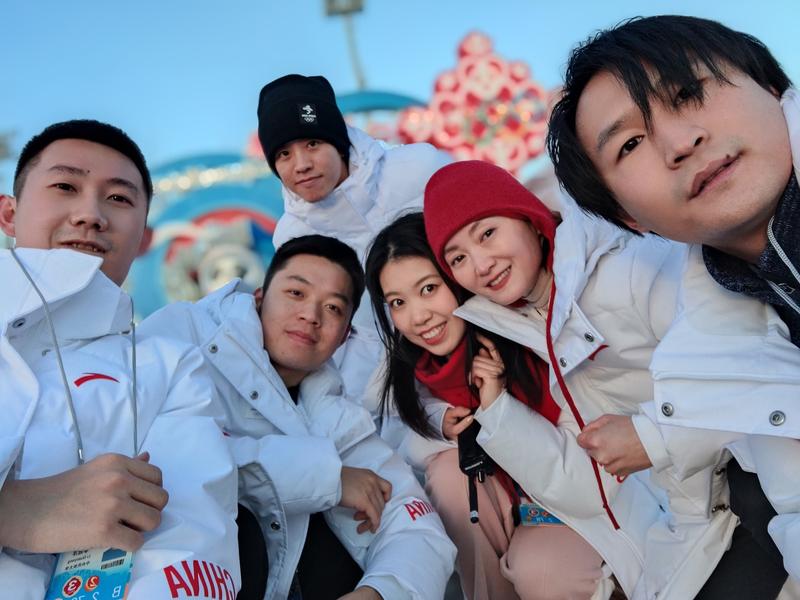 Choreographer Wang Yuanyuan (second from right) and members of her creative team. They worked to present the dance, Forming a Snowflake, as part of the opening ceremony of the Beijing 2022 Winter Olympics. (PHOTO PROVIDED TO CHINA DAILY)
Choreographer Wang Yuanyuan (second from right) and members of her creative team. They worked to present the dance, Forming a Snowflake, as part of the opening ceremony of the Beijing 2022 Winter Olympics. (PHOTO PROVIDED TO CHINA DAILY)
It was noon time on Sunday, two days after the opening ceremony of the Beijing 2022 Winter Olympics, which was directed by Zhang Yimou and held at the National Stadium, also known as the Bird's Nest.
The excitement of choreographer Wang Yuanyuan was still clear, even showing in her voice.
As one of the creative teams for the opening ceremony, Wang directed a 5-minute dance piece, titled Forming a Snowflake. She says she can finally sleep well.
"We were very nervous and concerned. We were not sure whether the audience would love the dance piece and we were also worried about making mistakes during the show," says Wang, during a telephone interview with China Daily from her home in Beijing. "After it was over, we got many messages of appreciation, which finally made us feel relaxed."
Viewers shared their excitement and praised the dance on Chinese social media, saying it was "romantic" and "beautiful".
The dance was performed straight after the parade of athletes during the opening ceremony on Friday. It began with 96 female dancers from the Beijing Dance Academy walking from around the edge of the performance area to the center of it together.
Each of the dancers, holding one of the snowflake-shaped team placards, danced across the over 11,000-square-meter floor of the stadium. They eventually gathered around a giant snowflake, made of individual snowflake-shaped placards-each representing the 91 nations and regions taking part in the Beijing 2022 Winter Olympics.
Wang received the invitation to join the creative team for the opening ceremony over a year ago from director Zhang. Then, along with her six team members, including visual artist Tan Shaoyuan, Wang began the choreography of the dance piece last summer.
"We tried many versions, hoping to deliver the message of togetherness and unity," Wang says, adding that the dance piece echoes the official motto for the Beijing 2022 Winter Games, "together for a shared future".
Since the stadium is very large, her team spent a lot of time working on the movements. For example, they did some math to make sure that each of the dancers arrived at the right point on the stage at the right time. They also worked with the audio and visual departments to design the moves, since the dancers performed with illuminated and changing images on the floor.
"We spent lots of sleepless nights in the venue, having meetings and changing plans over and over again. The final version was determined only a month before the opening ceremony," says Wang.
For Wang, the National Stadium means a lot to her personally.
Beijing is the first city to host both the Summer and Winter Olympics. The opening ceremony of the Beijing 2008 Summer Olympic Games also took place at the National Stadium, which was also directed by Zhang. Wang was a member of Zhang's team then, too.
Compared to 2008, which involved hundreds of thousands of dancers, the dance piece, Forming a Snowflake, had less than 100 dancers and was the only dance piece performed on the opening night.
"In 2008, we tried to introduce ourselves to the world by letting people know about our 5,000-year-old history. So we employed various means to achieve that goal. In 2022,14 years later, the country's international status is firmly established. We are stronger and much more confident," says Wang. "The opening ceremony is simple yet spectacular. We want to showcase contemporary China and the great future we will have."
As an old friend of Zhang, Wang is widely celebrated for choreographing the ballet piece, Raise the Red Lantern, directed by Zhang in 2001.
"He is full of energy and ideas. He always works day and night," says Wang of the film director.
"The grand opening ceremony is definitely a result of the efforts of many people and he trusted us," she adds.
Born and raised in Beijing, Wang started to learn Chinese dance at age 10 and graduated from the Beijing Dance Academy in 1995, before she studied contemporary dance choreography. From 2000 to 2002, she trained at the California Institute of the Arts' School of Dance in Los Angeles. In 2003, she was named resident choreographer at the National Ballet of China and was invited to serve as guest choreographer at the New York City Ballet.
In 2008, she founded Beijing Dance Theater, one of the country's most important contemporary dance companies, which tours worldwide. Wang has adapted some of the most famous Chinese stories and works of literature into her choreography pieces.



